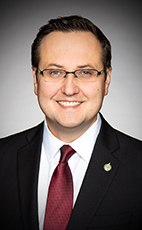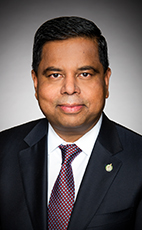44th Parl. 1st Sess.
April 21, 2023 10:00AM
Mr. Speaker, I want to begin by recognizing my colleague, the MP for Windsor West, for being a passionate champion of Ojibway all these years. I was glad to have the opportunity this past Monday to acknowledge the MP's 20 years of public service and his work to advance an Ojibway national urban park.
Our community gathered at Ojibway Nature Centre to celebrate four key milestones our federal government delivered through the work of the amazing Parks Canada. First, we announced the completion of the transfer of Ojibway Shores to Parks Canada. It is to be included in an Ojibway national urban park to be protected forever. Second, we announced that the first phase of the Parks Canada process in the creation of an Ojibway national urban park has been completed, and the process has graduated into the second phase. Third, we announced the acquisition and transfer of additional property on Titcombe Road to the City of Windsor for inclusion in an Ojibway national urban park. Finally, our community announced that the Province of Ontario has seen the value of an Ojibway national urban park and committed to transferring 60-plus hectares of provincial lands to Ojibway.
The credit for the protection of Ojibway Shores and the advancement of Ojibway national urban park rightfully rests with our community. Countless people have carried us to this tremendous day and time.
There are families, such as Derek and Ric Coronado, who have led efforts to protect Ojibway for decades. Karen Cedar, Paul Pratt and Tom Preney have poured their hearts and souls into looking after Ojibway for years.
From when I was a city councillor, I remember the number of times Jonathan Choquette came to fight for ecopassages and traffic calming to protect migrating wildlife. I have recently gotten to know professors Catherine Febria and Clint Jacobs, who opened the door to a deeper understanding of indigenous peoples' connections to Ojibway.
There are folks like Tom Henderson, Mike Fisher, Phil Roberts and Bill Roesel, who volunteer their time with the Friends of Ojibway Prairie and Essex County Field Naturalists' Club. There are people like Anna Lynn Meloche and Nancy Pancheshan, who rolled up their sleeves and took on developers and big box stores to elevate the urgency of conservation of Ojibway.
We can see so much courage, vision and togetherness, and there are hundreds of stories like this in Windsor Essex. They are as diverse and resilient as the plants and wildlife that call Ojibway home.
In addition to the people and groups I mentioned, there is the Detroit River Canadian Cleanup, Little Reg, URCA and the Unifor Local 444 environment committee.
These are the folks who will create an Ojibway national urban park. These are the drivers and the leaders, and this is the community. That is what gives me confidence and conviction that we will have an Ojibway national urban park: We are united, we are together and this is what we all want.
495 words
All Topics
- Hear!
- Rabble!
- add
- star_border
- share
Mr. Speaker, I am absolutely delighted to speak today in support of Bill C-248, an act to amend the Canada National Parks Act, Ojibway national urban park of Canada. I would like to thank the member for Windsor West for his hard work in bringing us here. I also want to acknowledge the work of the member for Windsor—Tecumseh for his advocacy.
I was able to visit this park when I was in Windsor about two months ago, and I was quite impressed with the enormous efforts that have been undertaken by the community, including the Friends of Ojibway Prairie.
I suspect that most of what I will say will be more of a reflection on the Rouge National Urban Park, which I am very proud to represent. This is how I want to frame it. On any given week, we have opposition day motions, and we have question period for around five hours. There is an enormous amount of back-and-forth among all the parties, and sometimes it is questionable as to what we are doing here and what this place really means.
After the seven and a half years I have been here, if I were to leave this place tomorrow or if I were to leave this place five years from now, the single most important thing that I would take away with me is the creation of Rouge National Urban Park.
I suspect the member for Windsor West is probably on a very similar journey to the one I am on. The reason is that this was a monumental achievement for us locally, for those of us who represented the Rouge park or, in this case, the Ojibway national park. It is monumental because, when we look back 30, 40 or 50 years from now, we will see that we were creating an enormous gem protecting our wildlife, protecting our natural habitat and ensuring there is ecological integrity in the hearts of some of the most densely populated places in all of Canada and North America.
As I look at the Rouge National Urban Park taking shape today, I often think of how we got there. I want to pay respect to a number of people who have been instrumental. I want to start off with Lois James, who, as members may know, was known as the mother of the Rouge. She unfortunately passed away several years ago.
We have tried to mark her success in so many ways, but the absolute legacy that she left is the park itself. Starting with her, and continuing with generations of activists who were inspired by her, we have managed to bring something very special to the greater Toronto area. We now have 79.1 square kilometres of protected space, with some of the most incredible wildlife protected, including the Carolinian forest. We have hundreds of endangered species, ecological areas and farms, which really do speak to the vibrancy of the park.
We had to do a balancing act to ensure that an established urban area could support a national park. Starting with Lois James, we went through the seventies and eighties, as the city of Toronto was sprawling. Scarborough was at that time a city of its own. It was sprawling, and there were enormous pressures for development because of shortages in housing.
We had activists. We had common citizens, including people who were principals, gardeners, students and people such as my friends Glenda Bearmaker, Jim Robb, Kevin O'Connor and others, who basically said that enough was enough. They saw that we had the historical Rouge River going through one of the most beautiful parts of the city, and if we were going to put development right in the centre of it, we would lose it and the ecological benefits that stemmed from it. People stood in front of bulldozers. There are stories of citizens who stood in front of bulldozers and said that enough was enough. They did not want to have development at the cost of the environment and the land.
I think the enormous sacrifices of the individuals there led us to the park today. I always say, with the member for Scarborough—Guildwood, that in many ways we are here as the last leg of this long marathon, but what we did was inconsequential compared to the work of the community itself, the fights the member for Nunavut was talking about and the enormous strides our community made.
Then, I look at all the people since then, the kids, the schools and the community. There will not be a week that goes by from now until the fall when we are not doing a tree planting. I, for example, am doing a “walk in the park”, as I call it, in the Rouge National Urban Park next Sunday, and there will be tree planting and a community cleanup tomorrow for Earth Day. There are tree-planting opportunities across the Rouge park that are done by organizations such as the Friends of the Rouge Watershed and Forests Ontario to ensure that the park is vibrant.
The unique nature of the Rouge park also means that we have active working farms with people who are recognized as heritage farmers. Farmers have farmed the area for a couple of hundred years. They have a form of tenure that allows them to continue until their demise, and we have new vibrant businesses that are taking shape, including what I am told is a microbrewery that is coming to the park.
Of course, this is all situated on the traditional lands of many indigenous nations, including the Mississaugas of the Credit. There are also the Huron-Wendat, who have a long history, including areas of the park where their history dates back over 10,000 years. The park itself is managed with enormous guidance from the indigenous circle that is part of the operations of the park, and there are regular and ongoing consultations that really allow the park to be sensitive.
There is one thing I have believed a park should do, and I am going to put it out there, because it is something that is quite important. I have had many conversations on this, and I hope at some point it will happen. The Rouge National Urban Park is the single largest display of the federal government within the greater Toronto area, and as such, I believe there is a need for more reflection on reconciliation at the park. For example, there is a need for a truth and reconciliation trail that would enable those who are visiting the park to be able to recognize the long and painful history of indigenous people in Canada, but particularly in the region.
Also, I think there is a greater need to ensure that we use the park to bring people back to nature and bring people back to what is, I think, most important, and probably the most important threat this country and this world are facing today.
I want to also acknowledge the work of Parks Canada's Andrew Campbell, who is the lead for Ontario, as well as Omar McDadl, who is the superintendent of the park. In the minister's office we have Joshua Swift, Kate and Jamie MacDonald, who have been incredible. There is also Janet Sumner of Wildlands as well as both former minister McKenna and the current Minister of Environment and Climate Change.
In closing, I think what the member for Windsor West is doing in collaboration with this community and many of the community members who are part of the Friends of the Ojibway Prairie is creating a legacy. It is not his legacy, but a legacy for all Canadians for future generations, where we can look back and say this is what we did in eight, 10 or 12 years of being here; we are protecting the land and making sure there is green space, and we are building a better Canada for all of us.
1344 words
All Topics
- Hear!
- Rabble!
- add
- star_border
- share
- menumenu
- notificationsnotifications
- home
- mailmail
- searchsearch




